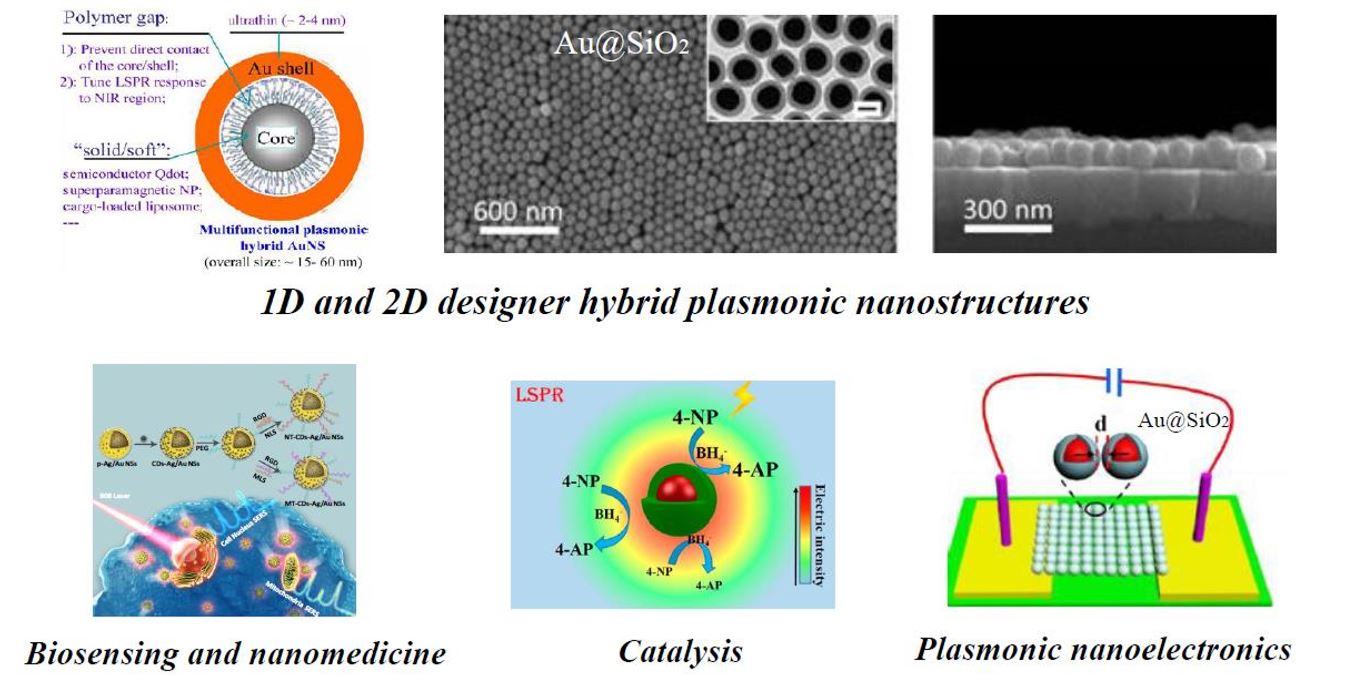Video Article Open Access
Designing Plasmonic Hybrid Nanostructures for Biosensing, Catalysis and Nanoelectronics
Yongdong Jin*, Chuanping Li
Changchun Institute of Applied Chemistry, Chinese Academy of Science, Changchun, 130022, China
Vid. Proc. Adv. Mater., Volume 2, Article ID 2021-0155 (2021)
DOI: 10.5185/vpoam.2021.0155
Publication Date (Web): 20 Jan 2021
Copyright © IAAM
Graphical Abstract

Abstract
Due to unique localized surface plasmon resonance (LSPR) properties and large electromagnetic field enhancement, noble metal-based plasmonic nanoparticles have been widely exploited for various applications. Gold nanoshells (AuNSs), representing one important class of nanostructures with tuneable LSPR peaks in the near-infrared region, have garnered considerable attention in recent years for a verity of biosensing and biomedical applications. Recently Jin and coworkers developed a new class of multifunctional hybrid AuNSs with ultrathin AuNSs and varied, functional (nonplasmonic) core components ranging from “hard” semiconductor quantum dots and superparamagnetic NPs to “soft” liposomes made using poly-L-histidine as a template to direct Au deposition, and explored its use for biosensing, multimodal imaging and controlled release; [1-3]. and the magnetic-plasmonic Fe3O4/Au core-shell NP enables a new biological imaging method –magnetomotive photoacoustic (mmPA) imaging, which offers remarkable contrast enhancement and improved specificity compared with photoacoustic images using conventional NP contrast agents [3]. We reported recently also a smart enzyme-responsive Ag/Au bimetallic NS system [4] and exploit it for sensitive nanoplasmonic glucose sensing, in situ nanoplasmonic probing of surface-confined enzymatic activity of GOx, and fast and sensitive in-vitro cancer cell imaging and screening. We also prepared a series of functional plasmonic NPs as SERS nanoprobes for single-cell studies to reveal molecular mechanisms involved during the stimuli-induced cell apoptosis process. Very recently, based on shell-isolated AuNPs system, we revealed a long-range plasmon field and plasmoelectric effect on catalysis by using p-nitrophenol as a model reaction and shell thickness-tunable and pinhole-free Au@SiO2 core-shell NPs as photocatalysts and sensing probes [4] Furthermore, by preparing shell-insulated Au@SiO2 NPs into 2D nanomembrane, we further revealed a surprising and unusual plasmon-mediated/enabled long-range electron transport regime (p-tunneling) of the system [5], and further exploited it as meta-surfaced electrode for ultrasensitive electrochemiluminescence (ECL) biosensing with over 1000-fold ECL enhancement [6] These findings will provide new insights into the understanding of plasmonic effects on catalysis and electron transport, and will benefit for the design of novel plasmonic nanocatalysts and nanocircuits.
Keywords
Plasmonic nanostructure; biosensing; nanomedicine; catalysis; nanoelectronics.
Acknowledgement
The research was supported by the National Natural Science Foundation of China, Chinese Academy of Sciences, and the National Key Research and Development Program of China.
References
- Y. D. Jin, Accounts of Chemical Research, 2014, 47, 138.
- Y. D. Jin, X. H. Gao, Nature Nanotechnology, 2009, 4, 571.
- Y. D. Jin, et al., Nature Communications, 2010, 1, 41.
- Y. D. Jin, et al., ACS Catalysis, 2017, 7, 5391.
- Y. D. Jin, et al., Scientific Reports, 2019, 9, 18336.
- Y. D. Jin, et al., iScience, 2019, 17, 267.
Biography
Yongdong Jin obtained his Ph.D. in Analytical Chemistry from the University of Chinese Academy of Sciences (Changchun Institute of Applied Chemistry of the Chinese Academy of Sciences) in China in 2004. He did his postdoctoral work at the Weizmann Institute of Science, Israel in 2004-2006, at UCLA in 2006-2007, and at Department of Bioengineering of the University of Washington, Seattle in 2007-2010. He is presently Professor of Chemistry at the State Key Lab. of Electroanalytical Chemistry, Changchun Institute of Applied Chemistry, Chinese Academy of Sciences. His current research interests include plasmonic nanostructures (especially for sensing, catalysis, and plasmon-enabled nanoelectronics), bio/nano interfaces and nano-medicine, and nanopore-based analytics. He has authored more than 100 papers in international journals, including Nat. Nanotechnol., Nat. Commun., PNAS, JACS, Adv. Mater., Natl. Sci. Rev., and iScience, etc.
Video Proceedings of Advanced Materials

Upcoming Congress



